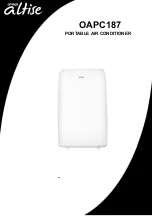
RXYQ8~1 RXYQ8~12P7YLK
VRVIII system air conditioner
Operation manual
7
8.
M
AINTENANCE
8.1.
Maintenance after a long stop period
(e.g. at the
beginning of the season)
■
Check and remove everything that might be blocking inlet and
outlet vents of indoor units and outdoor units.
■
Clean air filters and casings of indoor units. Refer to the
operation manual supplied with the indoor units for details on
how to proceed and make sure to install cleaned air filters back
in the same position.
■
Turn on the power at least 6 hours before operating the unit in
order to ensure smoother operation. As soon as the power is
turned on, the remote controller displays appear.
8.2.
Maintenance before a long stop period
(e.g. at
the end of the season)
■
Let the indoor units run in fan only operation for about half a day
in order to dry the interior of the units. Refer to
"6.1. Cooling,
heating, and fan only operation" on page 4
for details on fan only
operation.
■
Turn off the power. The remote controller displays disappear.
■
Clean air filters and casings of indoor units. Refer to the
operation manual supplied with the indoor units for details on
how to proceed and make sure to install cleaned air filters back
in the same position.
9.
F
OLLOWING
SYMPTOMS
ARE
NOT
AIR
CONDITIONER
TROUBLES
Symptom 1: The system does not operate
■
The air conditioner does not start immediately after the ON/OFF
button on the remote controller is pushed.
If the operation lamp lights, the system is in normal condition.
To prevent overloading of the compressor motor, the air
conditioner starts 5 minutes after it is turned ON again in case it
was turned OFF just before. The same starting delay occurs
after the operation mode selector button was used.
■
If "Centralized Control" is displayed on the remote control and
pressing the operation button causes the display to blink for a
few seconds.
This indicates that the central device is controlling the unit.
The blinking display indicates that the remote control cannot be
used.
■
The system does not start immediately after the power supply is
turned on.
Wait one minute until the micro computer is prepared for
operation.
Symptom 2: Cool/Heat cannot be changed over
■
When the display shows "
" (change-over under
centralized control), it shows that this is a slave remote
controller.
■
When the cool/heat slector is installed and the display shows
"
" (change-over under centralized control).
This is because cool/heat changeover is controlled by the cool/
heat selector. Ask your dealer where the selector is installed.
Symptom 3: Fan operation is possible, but cooling and heating do not
work.
■
Immediately after the power is turned on.
The micro computer is getting ready to operate. Wait 10
minutes.
Symptom 4: The fan strength does not correspond to the setting.
■
The fan strength does no change even if the fan strength
adjustment button in pressed.
During heating operation, when the room temperature reaches
the set temperature, the outdoor unit goes off and the indoor unit
changes to whisper fan strength.
This is to prevent cold air blowing directly on occupants of the
room.
The fan strength will not change even if the button is changed,
when another indoor unit is in heating operation.
Symptom 5: The fan direction does not correspond to the setting
■
The fan direction does not correspond to the remote control
display. The fan direction does not swing.
This is because the unit is being controlled by the micro
computer.
Symptom 6: White mist comes out of a unit
Symptom 6.1: Indoor unit
■
When humidity is high during cooling operation
If the interior of an indoor unit is extremely contaminated, the
temperature distribution inside a room becomes uneven. It is
necessary to clean the interior of the indoor unit. Ask your dealer
for details on cleaning the unit. This operation requires a
qualified service person.
■
Immediately after the cooling operation stops and if the room
temperature and humidity are low.
This is because warm refrigerant gas flows back into the indoor
unit and generates steam.
Symptom 6.2: Indoor unit, outdoor unit
■
When the system is changed over to heating operation after
defrost operation, moisture generated by defrost becomes
steam and is exhausted.
Symptom 7: The remote controller display reads "U4" or "U5" and stops,
but then restarts after a few minutes
■
This is because the remote control is intercepting noise from
electric appliances other than the air conditioner. This prevents
communication between the units, causing them to stop.
Operation automatically restarts when the noise ceases.
Symptom 8: Noise of air conditioners
Symptom 8.1: Indoor unit
■
A "zeen" sound is heard immediately after the power supply is
turned on.
The electronic expansion valve inside an indoor unit starts
working and makes the noise. Its volume will reduce in about
one minute.
■
A continuous low "shah" sound is heard when the system is in
cooling operation or at a stop
When the drain pump (optional accessories) is in operation, this
noise is heard.
■
A "pishi-pishi" squeaking sound is heard when the system stops
after heating operation.
Expansion and contraction of plastic parts caused by
temperature change make this noise.
■
A low "sah", "choro-choro" sound is heard while the indoor unit
is stopped.
When the other indoor unit is in operation, this noise is heard. In
order to prevent oil and refrigerant from remaining in the system,
a small amount of refrigerant is kept flowing.
Pay attention to the fan.
It is dangerous to inspect the unit while the fan is running.
Be sure to turn off the main switch and to remove the fuses
from the control circuit located in the outdoor unit.
4PW41759-1A – 08.2011






























